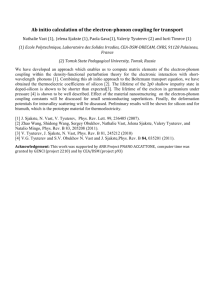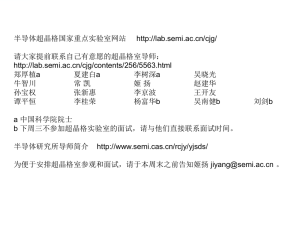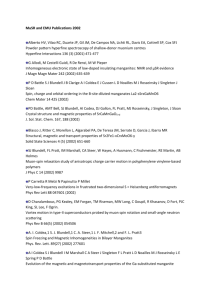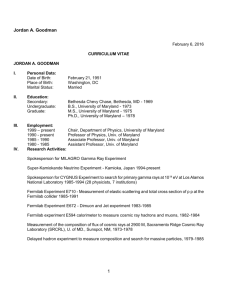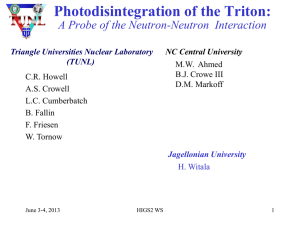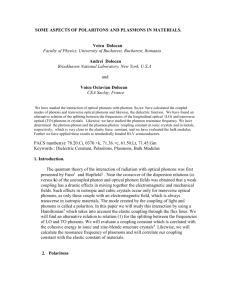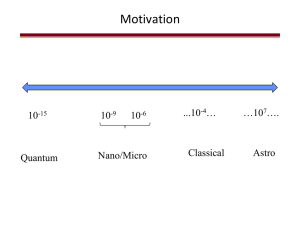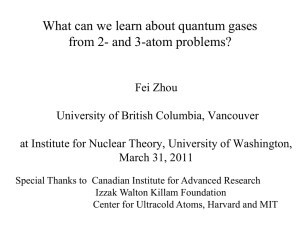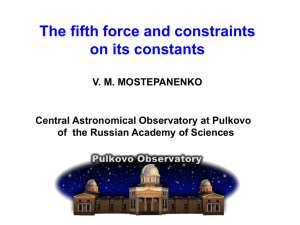T_c in pnictides and cuprates correlates with the electron
advertisement
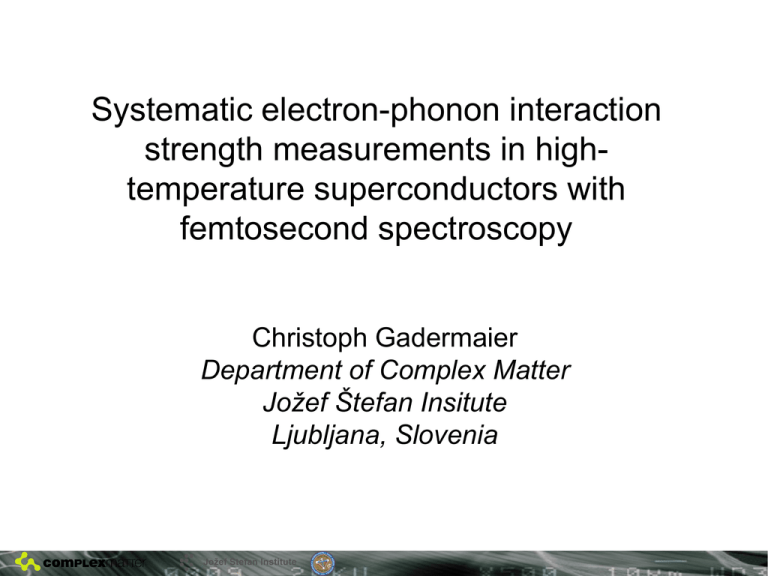
Systematic electron-phonon interaction strength measurements in hightemperature superconductors with femtosecond spectroscopy Christoph Gadermaier Department of Complex Matter Jožef Štefan Insitute Ljubljana, Slovenia Conventional superconductivity Electron-phonon interaction BCS: 1 k B T c exp Isotope effect: Image courtesy of B. Valenzuela What is the role of EPI in high-Tc? Determine electron phonon interaction from electron energy relaxation n (arb. units) 1.0 0.8 0.6 0.4 0.2 0.0 -100 -50 0 E-EF (arb. units) Image courtesy of G. Cerullo 50 100 The two-temperature model excitation hot nonthermal electrons hot thermal electrons cold thermal electrons EPI 2 cold phonons dissipation warm thermal electrons e-e collisions cold phonons EPI cold phonons cold thermal electrons dissipation warm phonons cold phonons k B Te 3 e ph P.B. Allen, Phys. Rev. Lett. 59, 1460 (1987). Validity of the TTM C. Kittel, p. 296: Ashcroft & Mermin, p. 348: P.B. Allen, Phys. Rev. Lett. 59, 1460 (1987): The non-equilibrium model excitation hot nonthermal electrons EPI+e-e warm nonthermal electrons cold thermal electrons EPI cold phonons 2 2 k B Tl 3 e ph cold phonons dissipation cold thermal electrons dissipation warm phonons cold phonons V.V Kabanov and A. S. Alexandrov, Phys. Rev. B. 78, 174514 (2008). e-e thermalisation is not faster than e-ph energy relaxation C. Gadermaier et al., Phys. Rev. Lett. 105, 257001 (2010). Metal data from S. D. Brorson et al., Phys. Rev. Lett. 64, 2172 (1990). Electron distribution during relaxation in Bi2Sr2CaCu2O8+d Exact distribution (t= Fermi-Dirac distribution n() 1 0.1 a) 0.01 -5 0 5 10 15 /kBT L. Perfetti et al., Phys. Rev. Lett. 99, 197001 (2007). Compare predictions of TTM and NEM TTM 2 NEM k B Te 3 e ph 2 2 k B Tl 3 e ph all fluences low fluence high fluence Te T L Te T L e ph c p T L e ph c p T L e ph c p T L e ph e ph I e ph e ph I e ph e ph I Te undefined Temperature dependent relaxation time T. Mertelj et al., Phys. Rev. B 81, 224504 (2010). We need to measure well above the pseudogap temperature Intensity independent dynamics in La1.85Sr0.15CuO4 1.4 1.2 R/R (%) R/R (arb. units) 1.0 0.8 0.6 1.0 0.8 0.6 0.4 0.2 0.0 0 100 200 300 400 500 600 2 pump intensity ( J/cm ) 0.4 2 70 J/cm 2 130 J/cm 2 270 J/cm 2 540 J/cm 0.2 0.0 -100 0 100 200 300 400 delay (fs) 400K < “Te” < 800 K C. Gadermaier et al., Phys. Rev. Lett. 105, 257001 (2010). Arguments for the non-equilibrium model • textbook knowledge • comparison of measured e-ph relaxation and estimated e-e thermalisation times • time-dependent electron distribution from ARPES • intensity independent dynamics • Determination of EPI strength in La1.85Sr0.15CuO4 620 nm 580 nm 540 nm T/T (arb. units) 1.0 0.8 a 45 fs b 600 fs 0.6 0.4 a e ph 0.2 2 k B Tl 3 2 0.0 -0.2 -100 0 100 200 300 400 2 800 meV delay (fs) C. Gadermaier et al., Phys. Rev. Lett. 105, 257001 (2010). 2 • Determination of EPI strength in YBa2Cu3O6.5 520 nm 560 nm 600 nm T/T (arb. units) 1.0 0.8 0.6 a 100 fs b 450 fs 0.4 a e ph 0.2 0.0 2 k B Tl 3 2 -0.2 -100 0 100 200 300 400 2 400 meV delay (fs) C. Gadermaier et al., Phys. Rev. Lett. 105, 257001 (2010). 2 The role of e-ph interaction in high-Tc Unpublished material removed. Please contact christoph.gadermaier@ijs.si Electron correlation D E T. Nakano et al., J. Phys. Soc. Jap. 67, 2622 (1998). Tc/Tc,max 1.0 0.5 0.0 0.0 0.2 0.4 0.6 0.8 1.0 1.2 1.4 1.6 1.8 2.0 x/xopt J.-H. Chu, Phys. Rev. B. 79, 014506 (2009). Collaborative electron-electron and electronphonon Unpublished material removed. Please contact christoph.gadermaier@ijs.si Bipolarons 140 BaFe2As2 YBCO HBCO BiSCO LaSCO 120 100 Tc (K) 80 60 40 20 0 0 1 2 3 4 5 TL/e-ph (K/fs) A. S. Alexandrov, Phys. Rev. B. 38, 925 (1988). Basic theory derived already in A. S. Alexandrov, Zh. Fi. Khim. 57, 273 (1983) before the discovery of high Tc 6 7 8 Stripes and other textures T. Mertelj, V.V. Kabanov, and D. Mihailovic, Phys. Rev. Lett. 94, 147003 (2005). Conclusion • electron-phonon interaction is determined from electron energy relaxation • electron energy relaxation is described by the nonequilibrium model, qualitatively even for non-Fermi liquids → TL/e-ph is a good measure of electron-phonon interaction • almost universal dependence of Tc of optimally doped compounds on TL/e-ph, sharp maximum at 5 K/fs → high Tc is a collaborative effect of electron-phonon interaction and electron correlation Acknowledgements • Primož Kušar, Viktor Kabanov, Tomaž Mertelj, Ljupka Stojchevska, Yasunori Toda, Dragan Mihailović • Sasha Alexandrov • Cristian Manzoni, Daniele Brida, Dario Polli, Giulio Cerullo • grazas pola súa atención
